#soil additives
Explore tagged Tumblr posts
Text
Perlite As A Growing Medium for Commercial Crop Production…
#Perlite #GrowMedia #PlantNutrients #CropNutrients #MicroNutrients #MacroNutrients #Fertilizers #GrowSupplies #CropProduction #Horticulture #Floriculture #CEA #Hydroponics #Aeroponics #Aquaculture #Plants #Crops #Greenhouses #Farms #Agriculture #AG #IndoorFarms #GrowRooms #GrowOps #Farmers #Farming #LosAngeles #LA #CA
0 notes
Text
Do you think Dungeon Meshi style golems would be possible at Castle of Nations
#soil is made of a mixture of inorganic and organic material#i really want to know what kind of cloth the climber is made out of because i think that would answer some of my questions#in a universe where karl gets turned into a human he dies within a matter of hours#does this rule apply to humans/other animals or to anything that's 'alive' (i.e. cotton works because it's no longer alive)#or does it apply to any organic materials. and the climber is made of polyester in addition to the synthetic foam he's stuffed with#castle of nations
2 notes
·
View notes
Text
!! WARNNING: ACTIVE BROADCAST AREA !!
MAKE A SQUEAK? BETTER GET THE HELL ON YOUR FEET!
>VACANCY FRIDAY THROUGH WEDNESDAY, OR FIND DJ AT ASTEROID DERBY!<
[NOW SCRAM!!]
#caps lock#unreality#had this in my drafts and i really love posting random tidbits you'd find in the zones so here you go#i think you'd find this nailed to the wall of one of those really small abandoned concrete houses with a beaded curtain entrance#it's a temp studio but most folk steer away from it becuse it looks like a really shitty pre-war bunker's front#it's just a building code violation though (shallow foundation on sandy soil with no additional support pillars) so it's totally fine
6 notes
·
View notes
Text

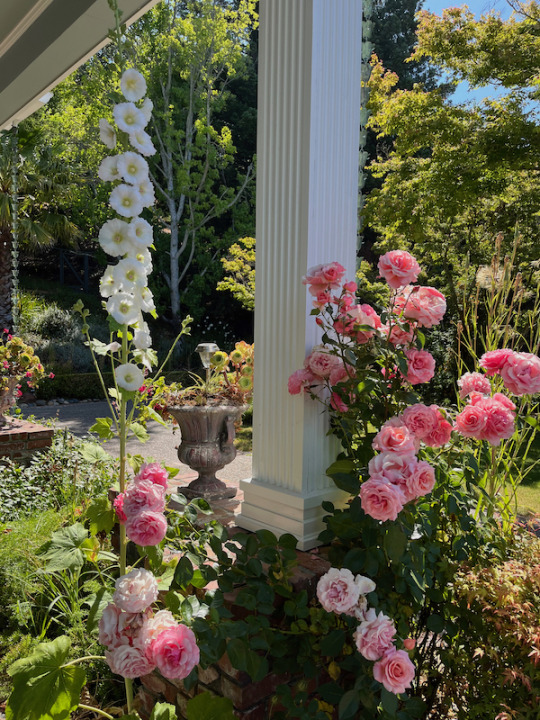


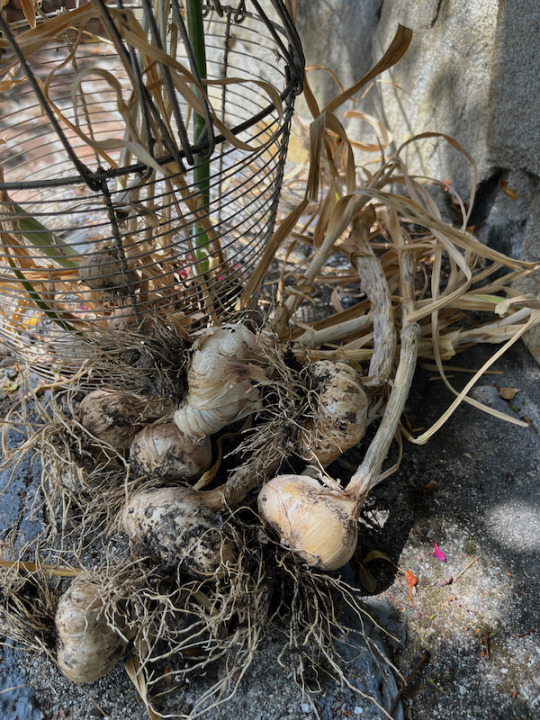

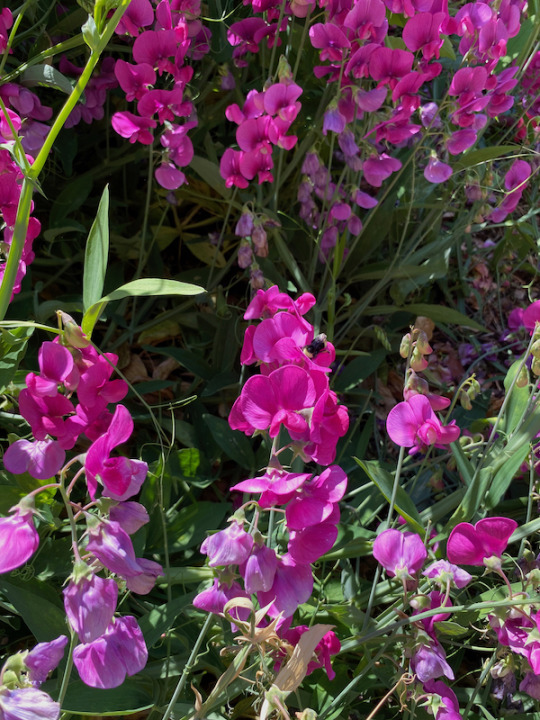

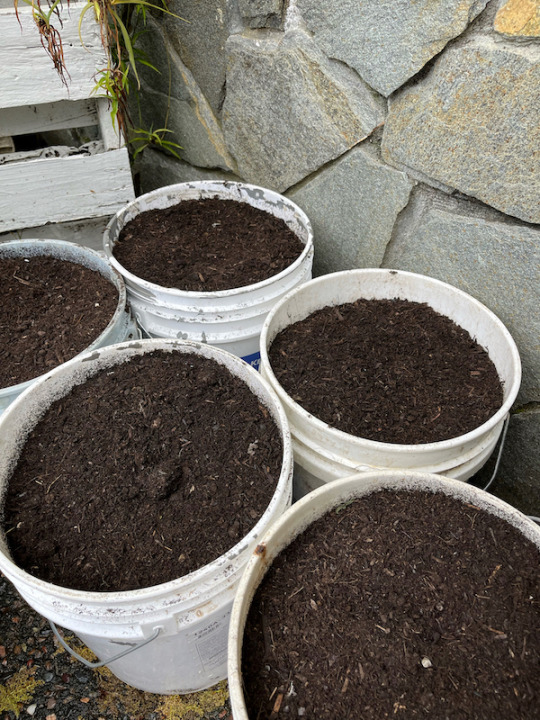
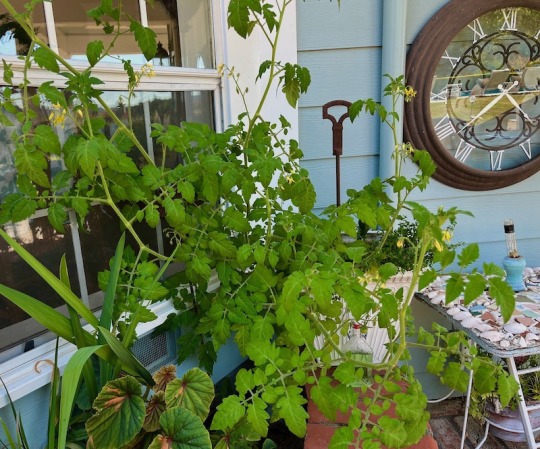
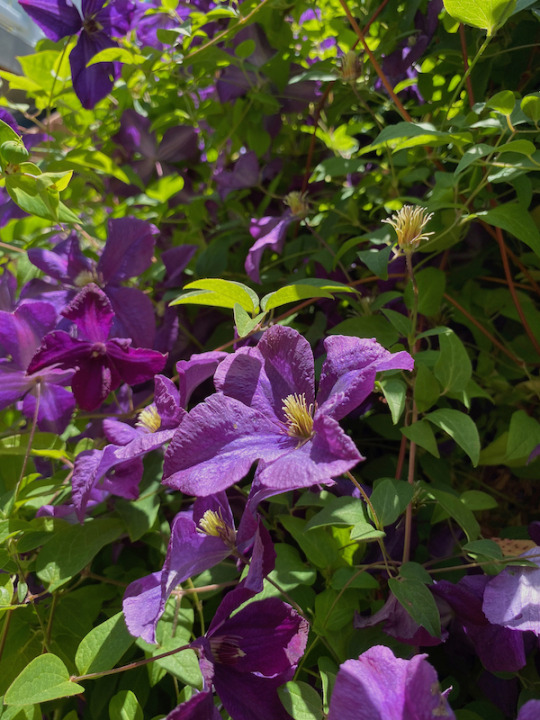
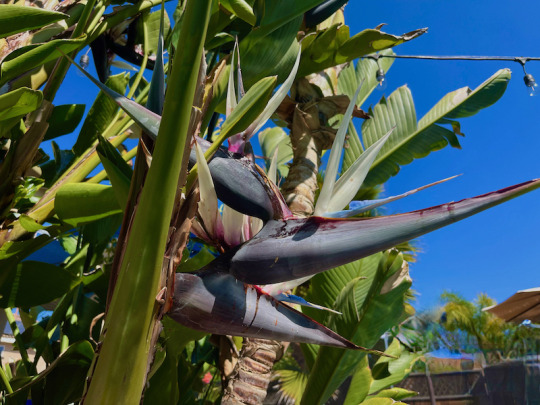
Joys of July Gardening:
#Gardening is the art that uses flowers and plants as paint#and the soil and sky as canvas.#Elizabeth Murray#The verdant hills have turned golden as the peak of summertime splendor arrives in July. The sunsets are sensational while the wonders of n#Color In and Out of the Garden by Lorene Edwards Forkner#and I find myself swinging in my hammock under my magnificent magnolia perusing the brushstrokes and hues of the garden as I turn the pages#Finally#my months of intense weeding are complete. My hands and fingers are still numb from the repeated motions#yet I am reaping the glorious joy of natures painted floral magic. My garden is indeed the lens through which I see the world.#The tapestry of color helps me learn to see with eyes wide open what the landscape produces this month. The compact Cezanne clematis boasts#they are flourishing providing continual bouquets of beauty and fragrance. Pink and purple appear to be my summer theme as purple trumpet v#festive summer surprise!#Birds of Paradise#both the orange and blue varieties#are showstoppers in gardens. Their flowers do indeed resemble birds. They are easy to grow#easy to maintain#and a wonderful addition to a garden when you are seeking a more tropical feeling. Speaking of birds#hopefully#you have included birdhouses#bird baths#and bird feeders in your garden design. Birds are one of our best pest control options. As a bonus#they serenade us with song and provide entertainment as they flit from limb to limb. Install a porch swing#bench#or hammock (my go-to) and enjoy the performance.#As an experiment#I planted tomatoes#thyme#peppers#and shallots in a large container outside my kitchen window so that I could grab and go. The plants are happy and thriving. I’ve already ha#and thyme
2 notes
·
View notes
Text





So we decided to expand the garden and also decided to solve the problem of the squirrels and birds digging up seedlings by building a screened-in frame around and on top of the garden, including a latching door! I helped hammer in the stakes for the structure, which was Not Easy at all.
And then we used PVC (attached to the stakes) because it's cheaper than buying enough cedar boards to construct it, and easier too (in some ways, including that it's very lightweight!)
Today we installed the door on some hinges and the latch! The mesh screen material should be arriving some time today so we might be able to get that done tomorrow when it's super warm out :) Oh and not shown here but we also added extensions on 3 of the 4 pvc tubes for the watering system, I drilled all of the holes in them!
#and then soil for the addition and compost and then add some fertilizer maybe idk and then!! we get Seedlingsssss#oh we forgot about the trellis for the cucumbers!#well...i guess we will figure that out...#anyway so yeah i woild like to do cucumbers and uh i just blanked on the edible vining flower plant i want to have share the trellis#and then maybe bell peppers#definitely chard and spinach and arugula#and adding marigolds and maybe some flowering herbs or some other small things in the mix#need to attract polinators fpr cucumbers and peppers after all
1 note
·
View note
Text
Can You Use Soil in Pots? Key Insights for Successful Planting
Understanding can you use soil in pots is vital for healthy container gardening. This guide examines the benefits and limitations of using garden soil in pots while offering practical advice on selecting and preparing the best soil mix for thriving plants.
#can you use soil in pots#container gardening soil#garden soil vs potting mix#improve potted plant growth#container soil preparation#plant nutrients in pots#soil additives for containers
0 notes
Text
The Rise of Plantain Banana Farming in Murang’a: Lessons for Small-Scale Farmers
A section of farmers in Maragua constituency Murang’a County are steadily embracing plantain banana farming and ditching the age-old common bananas. According to Fredrick Kinyanjui who has ditched the normal banana farming in favour of plantain, the normal bananas have continued to fetch less profits for the farmer over the years. He says he diversified to plantains after registering losses for…
#banana farming challenges#banana irrigation techniques#banana market prices#banana middlemen#banana value chain#high-yield bananas#Maragua farmers#Murang’a County#plantain agronomic practices#Plantain banana#plantain banana farming#plantain farming profitability#plantain health benefits#plantain market trends#plantain nutritional benefits#plantain suckers for sale#plantain vs traditional bananas#soil pH for plantains#sustainable farming practices#traditional bananas#value addition in banana farming.
0 notes
Text
So Venus is my favorite planet in the solar system - everything about it is just so weird.

It has this extraordinarily dense atmosphere that by all accounts shouldn't exist - Venus is close enough to the sun (and therefore hot enough) that the atmosphere should have literally evaporated away, just like Mercury's. We think Earth manages to keep its atmosphere by virtue of our magnetic field, but Venus doesn't even have that going for it. While Venus is probably volcanically active, it definitely doesn't have an internal magnetic dynamo, so whatever form of volcanism it has going on is very different from ours. And, it spins backwards! For some reason!!
But, for as many mysteries as Venus has, the United States really hasn't spent much time investigating it. The Soviet Union, on the other hand, sent no less than 16 probes to Venus between 1961 and 1984 as part of the Venera program - most of them looked like this!

The Soviet Union had a very different approach to space than the United States. NASA missions are typically extremely risk averse, and the spacecraft we launch are generally very expensive one-offs that have only one chance to succeed or fail.
It's lead to some really amazing science, but to put it into perspective, the Mars Opportunity rover only had to survive on Mars for 90 days for the mission to be declared a complete success. That thing lasted 15 years. I love the Opportunity rover as much as any self-respecting NASA engineer, but how much extra time and money did we spend that we didn't technically "need" to for it to last 60x longer than required?
Anyway, all to say, the Soviet Union took a more incremental approach, where failures were far less devastating. The Venera 9 through 14 probes were designed to land on the surface of Venus, and survive long enough to take a picture with two cameras - not an easy task, but a fairly straightforward goal compared to NASA standards. They had…mixed results.
Venera 9 managed to take a picture with one camera, but the other one's lens cap didn't deploy.
Venera 10 also managed to take a picture with one camera, but again the other lens cap didn't deploy.
Venera 11 took no pictures - neither lens cap deployed this time.
Venera 12 also took no pictures - because again, neither lens cap deployed.
Lotta problems with lens caps.
For Venera 13 and 14, in addition to the cameras they sent a device to sample the Venusian "soil". Upon landing, the arm was supposed to swing down and analyze the surface it touched - it was a simple mechanism that couldn't be re-deployed or adjusted after the first go.
This time, both lens caps FINALLY ejected perfectly, and we were treated to these marvelous, eerie pictures of the Venus landscape:

However, when the Venera 14 soil sampler arm deployed, instead of sampling the Venus surface, it managed to swing down and land perfectly on….an ejected lens cap.
#space#space history#venus#NASA#Venera#spost#I will talk all day about venus#ask me about venus floating sky cities#unpopular opinion venus > mars#this is probably my favorite space history story#the surface of venus is made of lens caps#don't try to tell me the universe doesn't have a sense of humor#well#I guess its more that people have a sense of humor and we happen to live in the universe
29K notes
·
View notes
Text
Unlocking the Future: Geopolymers Revolutionizing Construction
In an era where sustainability and innovation are paramount, the world of construction materials is witnessing a paradigm shift. Geopolymers, a class of materials that have been gaining traction in recent years, are emerging as a promising alternative to traditional cement-based products. With their potential to reduce carbon emissions, enhance durability, and provide versatile applications,…

View On WordPress
#3d printing#Additive Manufacturing#alternative materials#cement alternatives#construction innovation#cost competitiveness#Durability#environmental impact#Geopolymer concrete#Geopolymers#high performance materials#industry standards#Infrastructure Rehabilitation#infrastructure resilience#low carbon footprint#Material Optimization#public awareness#soil stabilization#Sustainable Construction#sustainable supply chain#versatile applications#waste management
0 notes
Text
This is so fucking petty compared to the overall headline that we are literally building a concentration camp on American soil but apparently they are actually, literally, making a moat and trench that will be stocked with alligators at the everglades concentration camp
Which is so fucking stupid for so many reasons but the fact that they are adding additional alligators, which are genuinely extremely docile animals, is fucking ridiculous and they genuinely won't do anything
However the AESTHETIC of it is extremely notable and some time down the line when the initial horror of we are building a new fucking concentration camp right now in Florida someone is going to write an essay about the ties between facism, masculinity, self perceptions of strength, and convincing men to turn a blind eye to atrocities and how it can be achieved by symbolic wildlife that they know jack shit about and have never interacted with, and is likely incredibly docile. Featuring bears, wolves, alligators, eagles, and more.
#no concentration camps are not a new thing in the US#it does not make this one any less horrific#or any less happening before our eyes
1K notes
·
View notes
Text
chapter 8: the lake a bridgerton au

pairing ⸺ duke!satoru gojo x fem!reader
summary ⸺ dearest gentle reader, a new season is upon us as the ton gets ready for a season filled with drama, heartbreak, and passion. after being crowned diamond of the season, duke gojo⸺only looking to marry just to secure his inheritance⸺has his sights set on you, the easiest (and most obvious) option. later, when you catch his saying unsavory things about you on a terrace when he least suspected it, you swear to never marry gojo. as london's fashionable set goes through yet another wedding season, will there be hope for scandalous gossip, hate, and thinly veiled insults, or will we witness blooming love and passion?
warnings ⸺ nsfw, enemies to lovers, bridgerton au, angst, fluff, SUGGESTIVE, making out, touching bare skin pre-marriage (the scandal), eventual smut, jealousy, misogyny, description of injury, concussion, blood, regency era au, gojo being infuriating, reader also being infuriating, both of them are clueless honestly
chapter summary ⸺ both you and gojo discover contradictory feelings lodged deep in your heart, and a confrontation (with an unexpected ally) leads to a rather....wet conclusion. (4.6k)
a/n additional warning that this chapter is not beta read. this may seem like a short chapter but it has TEAAAA (if you didnt already guess from the summary). i pushed myself to finish this for the peeps who finished finals this week so it may be a bit messy. anywho see u down below <3
prev. the rebound | next. the embers
general masterlist | series masterlist

Dearest gentle reader,
This Author finds herself most intrigued by the unfolding events of the Inos' recent ball. It appears that Her Majesty has not yet abandoned her faith in the diamond she so carefully selected. Will her confidence prove to be misplaced? Only time shall reveal the truth. Yet one cannot deny that fortune seems to shine—dare this Author say, sparkle—upon Miss Itadori of late.
Last evening, she graced the ballroom with a strikingly altered appearance, one that left tongues wagging and gazes lingering. Most notable, however, was the company she kept. Duke Nanami himself was seen at her side, engaged in conversation that appeared both earnest and uncommonly animated. A rare sight indeed, for His Grace has shown little interest in the charms of other young ladies this season. Could this be the beginning of something extraordinary? This Author will watch closely.
And who could forget the Gojo house party, where the drama rivaled even the most lurid novels of the circulating library? Whispers abound of a certain Lord Naoya Zen’in, who, it seems, departed the event looking rather... bruised, both in pride and in visage. What transpired to cause such a spectacle? Alas, my sources have yet to provide all the particulars, but one can only assume that tempers flared—and perhaps fists followed.
⸻ LADY WHISTLEDOWN’S SOCIETY PAPERS

Satoru wipes his knuckles on a spare handkerchief, marring it with streaks of crimson. After the blood coating his hand is cleaned off, it reveals light bruises.
He always abhorred such physical entanglements. Let other men soil their reputations in drunken brawls or duels over imagined slights; Satoru prided himself on wit and charm, a tongue sharp enough to parry any insult.
However, for the first time, it seemed that the blasé duke-to-be Lord Satoru Gojo, ever so apathetic to others and their struggles, was not so blasé anymore. What affected him was contradictory; after all, he had made a big decision to avoid being affected by the woman herself. So why was he so…inconsistent? Perhaps it is this unpredictability, capriciousness the reason he has to distance himself from any others who may be in harm’s way—the way forged by Satoru himself. There is no space for inconstancy, irresponsibility, whimsicality, or contradiction in his life, especially not with his duties and the weight held over his shoulders.
But he allows himself this, one last time. Your expression lingered in his mind—the way your lips parted in shock, the stiff set of your shoulders as you brushed past Naoya’s lecherous words without deigning to respond. He had seen the moment your composure faltered, a crack in the armor you wore so effortlessly. The crack only he was supposed to cause.
It was intolerable.
As soon as pale pink ribbons trail out of the room, he moves toward Naoya, completely ignoring the lady who was talking to him and her trailing protests. When he’s right in front of the other man, he gives him a curt nod. “Naoya.”
The other man’s eyes—which were before no doubt prowling on other unsuspecting ladies—flit to him in surprise. “Lord Gojo, what a pleasant surprise. I daresay—”
“Meet me in the courtyard,” Satoru interrupted, his tone leaving no room for argument.
Naoya’s brows shot up, but he recovered quickly, a sly grin curling his lips. “A private word? How intriguing. Lead the way, my lord.”
Satoru didn’t wait to see if he followed. His stride was steady, his purpose unwavering.
The cool air of the courtyard carried the faint strains of music from the ballroom, the chatter of guests dimmed by the stone walls. Satoru turned to face Naoya, his stance deceptively relaxed, one hand resting on the pommel of his cane.
“Now, my lord,” Naoya drawled, his smirk widening. “To what do I owe this rather dramatic summons?”
The reply came not in words but in the swift arc of Satoru’s fist, connecting solidly with Naoya’s jaw. The sharp crack of the blow shattered the stillness, and Naoya stumbled, clutching his face as shock registered in his eyes.
“What in blazes—”
“Hold your tongue,” Satoru bit out, seizing Naoya by the lapels of his coat and slamming him back against the cold, unyielding wall. His tone was calm, his voice low, but it carried a menace that silenced all protests. “You will not speak of her in that way again. Do you understand me?”
Naoya grimaced, his defiant eyes narrowing despite the pain. “Ah,” he sneered, a breathless rasp laced with derision, “this is about Miss Itadori, isn’t it? Playing the chivalrous hero, are we, Lord Gojo? Or is it your own wounded ego driving this display?”
The next punch silenced him mid-taunt, burying deep in his abdomen. Naoya doubled over with a strangled gasp, his knees threatening to buckle, but Satoru held him upright, his grip vice-like.
“Speak her name again,” Satoru hissed, leaning close, his voice cold enough to chill even the night air, “and I swear you’ll find yourself in far worse condition.”
The tension between them crackled like a storm. For a fleeting moment, Naoya’s lips twitched into the ghost of a sneer, but his words died unspoken, arrogance muted by the sheer force of Satoru’s fury. Satisfied, Satoru released him with a sharp shove, watching dispassionately as Naoya crumpled against the wall, gasping for breath.
“You are mad,” Naoya spat, wiping at the blood trickling from the corner of his mouth. “You’ll ruin yourself over this.”
“Perhaps,” Satoru replied evenly, smoothing the cuffs of his sleeves as though nothing had happened. “But I’ve never much cared for your opinion, Naoya.”
He turned on his heel, his steps measured, his expression impassive.
The sting in his knuckles was a small price to pay. Unfortunately it seemed that for you, it was a price he would pay again and again.
He had told himself the decision was rational. Logical. Your match had to cease because it had begun to unravel him. You were a distraction, one he could not afford. His life was designed for control, every action measured, every move calculated. A match with you, he had realized, would be unlike any other. It would mean more. It would demand more.
And yet, how could he feel this jealousy? This fierce protectiveness? It was contradictory, maddening even. His resolve to avoid entanglements of the heart warred against the memory of your laughter echoing through his mind. It was absurd, but he could not dismiss the sharp ache in his chest whenever you looked at another man, especially one so undeserving as Naoya Zen’in.
He had known from the start that you were different. No coy smiles or simpering obedience. No easy conquest to stroke his ego. Your instant rejection of him during your first meeting had been a blow to his pride and a revelation he had been too stubborn to acknowledge then.
Satoru was not a man who chased after women. He had no need to. And yet…
But even as he walked away, Satoru couldn’t help but feel the cracks in his own carefully constructed armor widening. What, indeed, was he doing?

You startle in your sleep, sitting up abruptly on your bed in the dark.
The season has taken a turn for the good, so far. With Whistledown singing your praises and the Queen not yet deciding to behead you, you were on the path of securing great prospects, whether it be with Duke Nanami or someone else.
“But you’re missing something, aren’t you?”
The voice is a low murmur, brushing the shell of your ear like the ghost of a touch. Your heart leaps to your throat as you twist toward the sound, your eyes darting across the dimly illuminated room. The corners of the chamber remain steeped in shadow, the moonlight doing little to ease your apprehension.
“Who’s there?” you whisper, clutching the sheets tighter, your knuckles whitening around the fabric.
The silence stretches, thick and oppressive, before a figure emerges from the shadow near the mantle. He moves with a predator’s grace, his steps silent against the floorboards. Even before he fully steps into the moonlight, you know who it is.
Gojo.
“You look startled, my lady,” he says, his voice carrying an infuriatingly casual lilt, though his gaze fixes on you with unnerving precision.
“This is a dream,” you murmur, your voice trembling despite your effort to remain calm. “You are not real.”
“And yet,” he replies. “here I am. Curious, isn’t it?”
You swallow hard, the lump in your throat refusing to budge. He’s closer now, standing at the foot of your bed, his pale hair catching the silvery light like a halo—an angel or a devil, you can’t decide. “What do you want, Lord Gojo?” you demand, your voice sharper than you feel.
His eyes sweep over you, lingering for a moment too long before meeting your gaze again. “To commend you, of course,” he says. “You’ve been doing well—dancing with dukes, charming the Queen. The season’s darling.”
His words cut, though you can’t say why. “Why does that matter to you?” you snap, sitting straighter, as though defiance could shield you from the heat simmering in his gaze.
“It doesn’t,” he replies smoothly, though the corner of his mouth quirks into a smirk that betrays him.
“Then why are you here?”
His answer doesn’t come in words. Instead, he steps closer, his boots brushing the edge of your rug. Slowly, deliberately, he reaches out, his gloved hand catching a strand of hair that’s fallen loose. He rolls it between his fingers, as though testing its silkiness, before letting it slip away. “Because I can’t seem to stay away,” he murmurs. His voice is low, meant only for you, and it sends a shiver through your body.
You scoff, though the sound catches in your throat. “You’re insufferable.”
His chuckle is soft, a deep rumble that seems to linger in the air. “And yet, you don’t look away.”
Your fists clench around the sheets, anger flaring in your chest—anger at him, at yourself, at the fact that he’s right. Before you can stop yourself, you throw the covers aside and rise to your feet.
He doesn’t step back. Instead, he stands still, a study in casual defiance, though his gaze flickers with something you can’t name as you move closer. His eyes lazily drag up and down your frame, which you notice is only covered in a flimsy, almost translucent nightgown.
“If this is a dream,” you say, your voice trembling with fury and something unspoken, “then it doesn’t matter what I do, does it?”
His smirk falters, replaced by a glimmer of uncertainty that only fans the reckless fire inside you. “Perhaps not,” he murmurs, though the tension in his voice betrays him.
Your hands shake as you reach out, your fingers curling into the lapels of his coat. His eyes follow the movement, then stare back at you, into your eyes. For a brief moment, his breath hitches, and his hands twitch at his sides, as though warring with the instinct to touch you. But the flicker of surprise in his eyes tells you he didn’t expect this.
With a sharp tug, you pull him closer, your lips meeting his in a collision of unspoken longing, yearning, and pining. The kiss is unsteady at first, as if both of you are testing the waters, but it quickly deepens, becoming a clash of fire and desperation. His hands find your waist, his grip firm but not demanding, as if he’s holding on to something precious.
You press closer, letting the reckless freedom the dream gave you sweep you away. His lips part against yours, and the kiss turns slower, more deliberate, like he’s savoring the moment, savoring you, devouring you. But then, his hands shift, moving from your waist with a slow, tantalizing seductiveness. They skim over your hips, his touch deliberate, before trailing down to the curve of your thighs. His fingers brush over the soft fabric of your nightgown, the heat of his touch searing through the barrier like it isn’t there.
Your breath hitches as he lingers, his thumb tracing a path along the sensitive skin just above your knee. The sensation is electric, and yet it feels like forbidden ground—an intimacy you’ve never dared to imagine, even in your most audacious thoughts.
It’s then that the dream begins to unravel.
His form flickers, as though caught in the haze of a mirage, the sharp lines of his figure softening. The room darkens, the corners of your vision blurring as though the world is folding in on itself.
“No,” you whisper, the word barely audible over the sound of your own pounding heart.
He looks at you one last time, his eyes filled with an intensity that feels as real as your racing pulse. And then he’s gone, the dream dissolving into nothingness, leaving you gasping and clutching the sheets. When you wake, the echo of his touch lingers, the heat of his hands on your thighs an ache you can’t explain. You press trembling fingers to your lips, your breath catching as though the kiss was still happening.
But no matter how much you try, you can’t shake the memory of his hands, of the way he’d touched you like he belonged there. Like he had always belonged there.

You choose to blame the irregular slumber you have gotten this past fortnight as the reason why you are being so discourteous. For Duke Nanami’s words drift your mind, never truly being registered, as you both had strolled, promenading hand in hand.
It is not merely His Grace who suffers from your inattentiveness. Any suitor who dares to approach is met with the same distracted gaze, your thoughts elsewhere. Whether it is the lingering remnants of that unbidden dream—one you’ve tried and failed to forget—or the fleeting moments where you think you spot Lord Gojo across the green only to realize it is a figment of your imagination, your mind is a battlefield.
A few awkward conversations—where you are not truly present—pass and go, until you sit by the lakeside of Surrey Park, deciding to take a break from the conversations that awaited you if you were to stroll towards your family’s pavilion.
But not now, for here, nature offers solace. The gentle ripple of water, the soft rustling of leaves, the occasional bird song—all soothe the cacophony in your head.
You settle onto a bench, your gown fanning around you, and allow yourself to breathe. But even as you close your eyes and tilt your head toward the sun, the peace does not come. Your thoughts betray you, circling back to him—his infuriating smirk, his piercing gaze, the way his voice seemed to linger in the air long after he was gone. The dream was completely unbidden, unexpected. You had only started to move on and start this season anew. It seemed as your consciousness was working against you in an effort to bring fictional desires to life.
You knew clearly that Gojo was infuriating, and had colored your name. So why must your mind actively go against what was clearly a certitude?
Before you could ponder on your thoughts for much longer, you heard her.
“You do seem terribly at ease for someone of your…reputation.”
The voice startles you, cutting through your reverie like a blade. Your eyes snap open, and there stands Lady Mei Mei, her expression a mask of genteel venom. You sigh inwardly, and bring on your best smile, albeit artificial. “Lady Mei Mei,” you greet, striving for composure. “To what do I owe this very unexpected…interruption?”
“Interruption?” she echoes, feigning offense. “How quaint. I merely wished to congratulate you on your newfound popularity. Though, I must say, the…boldness of your wardrobe choices does make one wonder.” Her gaze drags over your form, disdain dripping from every word. “Are you seeking a husband, my dear, or something far less respectable?”
Your fingers curl into the fabric of your skirt, but you maintain your poise. “Boldness, Lady Mei Mei, is often mistaken for confidence by those unfamiliar with either.”
Her lips twitch, but the venom remains. “Confidence, or desperation? It is difficult to tell with one so eager to flaunt herself before the ton. Tell me, do you find it tiring? Whoring yourself out for attention?”
The word lands like a slap, sharp and stinging, and you feel the surge of heat rise to your cheeks. Slowly, deliberately, you rise to your feet, smoothing the folds of your gown as you stand. Your chin tilts upward, a shield of composure against the venom Mei Mei has hurled your way. You desperately fight the urge to slap her into nonsense, but there are eyes, no matter how hidden from public view you may think yourself to be.
“I find it far less tiring than wielding envy as one’s primary weapon,” you reply, your voice cool yet cutting, every syllable sharpened to a blade. “But then, I would not expect you to understand.”
Mei Mei’s lips twist into something that might have been a smile, had it not been dripping with malice. Her eyes narrow, the sunlight catching the cold glint of her stare. She shifts closer, the deliberate grace of her steps at odds with the tension crackling in the air. For a moment, you think she might lash out—a slap, a shove, something physical to match her words.
But before the storm can break, a voice, smooth and deceptively warm, cuts through the charged silence.
“Lady Mei Mei.”
Your breath hitches, and you whip your head around to see him. Lord Gojo strides toward you both, his movements as fluid and effortless as a ripple across the lake’s surface.
For a moment, your mind stutters, unable to reconcile the sight before you. He’s here. Not lingering at the edges of the crowd, not offering a polite nod of acknowledgment before disappearing into the fringes of Surrey Park. No, he’s walking toward you with purpose, the light catching in his silver hair, his focus unerringly fixed on the scene unfolding before him.
The man who had, for days, seemed to find every excuse to avoid you (and you him), whose gaze had flicked past you as though you were nothing more than a fixture of the lawn—he was now approaching with a startling intensity, his presence impossible to ignore.
His expression is inscrutable, but the faint furrow of his brow betrays something darker beneath the veneer of his charm. The tension in his jaw, the faint set of his shoulders—it all speaks of an intent that sends a shiver down your spine.
“Lord Gojo,” you whisper under your breath, your voice barely audible over the blood rushing in your ears. What is he doing here? And why, when he looks at you, does it feel as though the air has shifted?
Lady Mei Mei recovers first, her voice cutting through your disarray like a blade. “Lord Gojo,” she purrs, her saccharine tone a stark contrast to the venom she had wielded moments earlier. “What a surprise to see you here.”
But you can’t take your eyes off him. You’re too stunned, too disoriented by his sudden appearance and the sheer force of his presence. Why must he appear now?
His gaze flicks briefly to Mei Mei, his lips curving into a polite smile that doesn’t quite reach his eyes, before his attention returns to you. And when it does, it’s as though the world narrows to the space between you.
“Not half as surprising as overhearing this delightful conversation,” he says, his tone light, almost lazy, but there’s an edge to it—a sharpness that wasn’t there before. His eyes meet yours again, and this time, the intensity in them is impossible to ignore. Your breath holds itself in, your confusion and shock colliding with something you can’t quite name. There’s no teasing quip, no playful smirk to soften his words. Just the weight of his gaze, pressing down on you as though he’s searching for something you don’t understand. Then, he returns it to Mei Mei. “I was unaware you had taken to dispensing moral judgments, my lady. Though I suppose one must occupy their time somehow.”
The barb lands, and Mei Mei’s smile falters. Her spine stiffens, her fingers twitching at her side, but Gojo doesn’t stop. He steps closer, his boots crunching against the gravel, and the shift in his demeanor is subtle but unmistakable.
“I would suggest, for the sake of civility,” he says, his voice softening to something far more dangerous, “that you refrain from such remarks in the future.”
The crowd, drawn by the commotion, murmurs from a distance. You feel their gazes prickle against your skin, their curiosity thickening the already-tense air. Mei Mei’s cheeks flush a pale pink, and her hands clench at her sides, the effort to maintain her composure palpable.
“You dare—” she begins, but Gojo cuts her off, his voice a degree colder now.
“I dare a great many things, my lady. Do not test the limits of my patience.”
The words hang heavy in the air, silencing the murmurs of the crowd. Mei Mei’s breath quickens, and though her lips curl into a sneer, the fire in her eyes dims. After a moment, she dips her head again, but this time it’s no longer polite. It’s forced, a concession.
“Very well, my lord,” she says, her voice tight. “I can see when my presence is no longer welcome.”
Lady Mei Mei walked past you to exit the scene, clearly disgraced after Lord Gojo had surprisingly butted in to your defense. Her turn was sharp, and her skirts flared. Then, she did something you hadn’t expected. After all, you were nonplussed from Gojo’s appearance in of itself that you did not have much awareness of your physical environment. Foremost of all, you were furious. How dare he waltz into the scene, aiming at playing hero and gentleman after all he has done to you this season? The anger consumed you, leaving you ignorant to Lady Mei Mei's schemes.
The movement came quickly—a flick of her hand, subtle yet purposeful, as though she intended to brush away an inconvenience. Only, her target was not the hem of her gown or an errant lock of hair. It was you. That is, that was the intention of the action. However, fortuitously enough for you, Lord Gojo had noticed it.
With a sharp tug, his hand closed around your wrist, pulling you aside just as Lady Mei Mei's push landed—on him.
The splash was enormous.
For a moment, the world stood still, the lake swallowing the ripples as though it too were stunned by what had just transpired. Around you, gasps echoed, punctuated by the soft clink of champagne glasses dropped in surprise. All eyes turned toward the water, toward the spot where Gojo had disappeared.
Your pulse pounded erratically, caught between the shock of it all and the mortifying realization that everyone was watching. Watching and waiting.
And then, like something out of a scandalous painting that no young lady of good breeding ought to admit having seen, Gojo emerged.
The water clung to him as though reluctant to let go, his white shirt turned sheer and pasted to his torso, revealing every lean muscle and curve beneath. Droplets trailed from the tips of his silver hair, tracing maddening paths down the sharp edges of his jaw before disappearing beneath the soaked fabric. His black necktie clung damply to his throat, accentuating the hollows there, and when his eyes met yours—gleaming with mischief and something darker—your breath hitched.
It was obscene.
The crowd seemed to agree, though their response was far less scandalized than you might have expected. The ladies weren’t laughing; no, their gazes were riveted, their fans fluttering in a feeble attempt to hide their obvious fascination. Their admiration was palpable, their whispers laden with awe.
Flustered, you took a few steps back to give him space and to not drench yourself (a/n lmaooo you’re drenched already bestie), but you mentally noted to yourself to make his pectorals bigger in your dreams (not that you would continue to have such salacious dreams, of course. It was the mind creating desires you never had, obviously.) It was apparent that you were still very distracted, for you did not notice the two pairs of footsteps rushing towards your direction, towards Gojo.
“What happened?” Duke Nanami looked at Gojo’s very…wet state, concerned and alarmed. “What did you get yourself into this time, Satoru?”
Gojo, who was still wiping water from his hair and grinning like a fool, gave him an exaggerated look of innocence. He ran a hand through his damp, platinum hair, the gesture almost too casual for someone in his drenched state. As he did so, the hem of his shirt inched upward, revealing a tantalizing sliver of bare skin, a sliver that led downward to a trail of white hair disappearing beneath his waistband—
“Kento,” Gojo laughed heartily, as if there were nothing amiss. “You worry too much! A little water never hurt anyone.”
Lord Geto, on the other hand, had been trailing behind Nanami. At the sight of Gojo, he started laughing, snickering mischievously at the sight. He had a knowing look on his face, as if he were fully aware of the scene he was witnessing—Gojo’s accidental plunge into the lake being just another moment of unintentional chaos.
“Oh, Satoru, you're impossible.” Geto stepped closer, shaking his head in mock disbelief, but his smile was far too amused to be truly accusatory or reproachful. "Did you get knocked into the lake by your own... charm?" His voice dripped with sarcasm as he glanced at the crowd of ladies now eyeing Gojo as though he were some mythical creature freshly emerged from the depths.
Nanami sighed, his brow furrowing as he crossed his arms in that ever-earnest manner that seemed to constantly play contrast to Gojo’s reckless energy. “This is exactly why you need a keeper at all times, Satoru.”
Gojo, still basking in the odd mix of amusement and the lingering attention of the nearby ladies, merely shrugged. “I’m fine, Kento. Just a little... refreshment is all.”
“By the looks of it,” Geto continued with a raised brow, “I’m more concerned about you than you are of yourself.” He gestured with a lazy wave, motioning toward the way the water had soaked through Gojo’s shirt, revealing a lot more than was likely intended. “And, I mean, look at that—those ladies aren’t gazing at you for your intellect.” (a/n LMAO ate him up)
Before Gojo could lob a retort, Nanami interjected with his trademark no-nonsense tone. “Enough of this,” he said, pinching the bridge of his nose. “You’re soaked to the bone. Let’s get you inside before you catch a chill—or create an even bigger scene.”
Gojo lingered for a moment, casting a leisurely glance around the gathering. The ladies, previously locked in their own conversations, now shamelessly ogled him, their fans fluttering uselessly against the rising heat in their cheeks. Their gazes trailed after him as he started to walk away, and you swore you caught more than one wistful sigh among the crowd.
And yet, even as he moved farther from the lake and closer to the house, his steps deliberate and unhurried, he suddenly stopped. Slowly, his head turned, and his piercing blue gaze found yours with unnerving accuracy, as if he’d felt your bewildered stare all along.
His smile appeared—lazy, confident, and maddeningly seductive. The corner of his mouth tilted up just enough to make your stomach flip, and his eyes... Oh, his eyes. They gleamed like a predator’s, sharp and teasing, and yet impossibly inviting.
The world seemed to tilt, the air around you thickening. Your chest tightened with the realization: that smile wasn’t for the crowd, nor for the fawning ladies he left in his wake.
It was for you.
Your cheeks burned, your thoughts a chaotic mess as he turned back and sauntered away, water still dripping from his hair and shirt. The ladies continued to gawk openly, but you remained rooted to the spot, your heart pounding erratically.
Oh, that bastard.

prev. the rebound | next. the embers
general masterlist | series masterlist
a/n so....erm this was definitely a CHAPTER.....BUT AH POOKIES ITS HERE i got so excited bc i got the idea to write his lake fall so i finished this chapter. it's a bit messy, like i said, but i hope you liked it <333
I WANT TO SUCK GOJOS DICK BADLYYY i think this chapter was posted so fast after the last bc im on my period and im horny so hence the lake scene was born like i rawdogged this shit in five hours
ANYWYAS THERES PUSH AND PULL YEARNING PINING...so much contradiction hmmmmmm
miss itadori malfunctioning when gojo got out of the water (like a complete SLUT)


anyways i hope some of you WHORESS that simped for bridgerton!geto will be coming anew to simp for our main MAN. this debauchery i approve of. i fear all anons, especially zaynesbathrobe anon and anon in my walls, will be having a field day with this one
thank you for readinggg! please comment and reblog to let me know ur thots :3 (esp reblog, a lot of people have been binging bridgerton!gojo recently and spam liking. tumblr daddy might lock me up and shadowban me/mark my account, so reblogs would be appreciated <3)
TAGLIST:
@ncitygreen @backstagepaige @serinatly100986 @nappingmoon @coochellati
@extremelyexh4usted @yoshisaurmuchakoopas @nixiepixee @generalstephkenobi @vernasce-blogs
@byhuenii @geniejunn @a-girl-with-thoughts @dazedin2d @chuuqxs
@megumiivs @anthastudios @arranacosmist @arishaxml @jingyuun
@undercooked-chaos-noodle @jaegersity @camzzn @bluelai @1sweetheart1
@hyori2 @babyblue0t7 @iwanttoberich420 @rosso-seta @ladytamayolover
@kalulakunundrum @r0ckst4rjk @mo0sin @angelina7890 @jaeminaur
@yamiyas @cherry-blossoms-in-red @r3inae @lagataprrr @sasfransisco
@fortunatelyfurrygiver @aurora-tiny @gojonegs @luna-v-roiya @xxemmarldxx
@soobssedwithyourex @manyno @samkysnks @stefnarda @bbqsauceonmytitties2
#aashi writes#jjk x reader#jjk fanfic#jjk smut#gojo smut#gojo x reader#gojo x you#gojo satoru#gojo rec#gojo fluff#gojou satoru x reader#gojo satoru x you#satoru x reader#jjk#jjk x you#gojo fanfic#gojo ff#jjk ff#jujutsu kaisen#satoru gojo#jujutsu kaisen gojo#gojo#divider by cafekitsune#jjk series#gojo series#gojo satoru series#gojo satoru x reader#gojo satoru smut#gojo satoru x y/n#gojo satoru fluff
2K notes
·
View notes
Text
"He is interested in two things and two things only: making you afraid of it and telling you who's to blame for it. That, ladies and gentlemen, is how you win elections. You gather a group of middle-aged, middle-class, middle-income voters who remember with longing an easier time, and you talk to them about family and American values and character. And wave an old photo of the President's girlfriend and you scream about patriotism and you tell them, she's to blame for their lot in life, and you go on television and you call her a whore." The American President (1995)

They hate the same people!
#reblogging for my friend nora's outstanding addition#i enjoyed the movie#but this paragraph has always struck me as true#there's a party of the hopeful#and a party that would soil their trousers at “boo”#i know what party i'm voting for
288 notes
·
View notes
Text
Is this the Largest Sweet Potato in Kenya? The Inspiring Story of Manoah Kilach's 11-Kilogram Sweet Potato
In the verdant Ngata area of Nakuru County, Manoah Kilach has transformed agricultural practice through meticulous organic farming and technological innovation. A retired educator turned agricultural entrepreneur, Kilach stands as a testament to the potential of modern, sustainable farming techniques. On a sun-drenched Friday morning, Kilach proudly displayed an extraordinary achievement: an…
#agricultural innovation in Kenya#crop diversity in Kenya#crop production in Nakuru#farming education hubs#farmyard manure use#holistic farming approaches#Kabode sweet potato#Kalro farming techniques#Kenspot One#Kenyan agricultural entrepreneurs#large sweet potato yields#local farmer networks#Manoah Kilach#modern farming methods.#Nakuru farming innovations#Ngata sweet potato farming#Organic farming practices#record-breaking sweet potatoes#soil health management#soil nutrient testing#sustainable agriculture#sustainable farming practices#Sweet Potato farming in kenya#sweet potato flour production#sweet potato market in Nairobi#sweet potato nutritional benefits#sweet potato varieties in kenya#technological adoption in farming#value addition in agriculture#value-added agriculture
0 notes
Text
Ghost in the Wind — Part Five

SUMMARY: Harnessing your power is growing easier by the day, and Madja finds out some interesting things about witches souls.
WARNINGS: swearing, mentions of torture, kissing, teasing, fingering, handjob, oral (female receiving—all of this is somewhat public), mentions of death
WORD COUNT: 6.4k
Series Masterlist

Cassian struggled against the vines that wrapped tight across his midriff, his muscles flexing with power but nothing shifted as they tightened with his every move. His golden skin was coated in a thin sheen of sweat, his shoulder-length hair damp with excursion.
You were no better. Your chest rose and fell rapidly, your skin flushed as your knees began to buckle. Hold it. Rhysand’s voice had continued to purr into your mind throughout the session, guiding and commanding every step of the way. He worked you from sunrise to breakfast, then again from dusk until nightfall.
It had been your routine for the past two weeks, and with every session, your power and control grew stronger. You could now detain a being with nothing but your mind, could bound and gag with vines and soil. This session, however, was different. Because it wasn’t just vines that wrapped across Cassian’s arms and legs and torso.
This time, the vines had thorns. And they pierced his skin deeper with every movement he made.
It had taken an additional two weeks to get to this point. Two weeks of introducing the Inner Circle to your magic, of slowly allowing them past the protective walls your abilities offered. You no longer had to keep your distance from your friends and family. It appeared the only time your magic attacked on its own was when you were startled or afraid.
You’d been at it for sixty minutes already, your brows dotted with sweat. Rhysand continued to slowly pace the training ring atop the House of Wind. Feyre stood off to the side, a towel in one hand and a glass of water in the other. Nesta watched from beside her, arms crossed against her generous chest as she squinted at the way her mate seethed in discomfort.
So far, Cassian had not been able to break free from your bindings, nor had he been able to move a single muscle more than an itch. And Rhysand was more than impressed.
“Good,” he complimented, a noticeably proud smile on his face. At that, you slowly released your power and took a heaving breath of relief. The vines lazily slithered from Cassian’s body, the thorns leaving scratches in their wake that healed almost immediately.
“You’re presenting incredible control. Tomorrow, I’d like for you to make those thorns bigger. And by next week, I’d like to see if you can implement a slow releasing toxin or poison.”
Cassian widened his eyes at his High Lord. “I’m not volunteering for that.”
A smile found your lips as you took a few breaths to settle your lungs again. You had never expected training to be this rewarding. Rhysand was nothing but attentive to your powers and how they worked. He made sure you felt comfortable with everything you tried and he never once tried to push you beyond your limits.
When you expressed you first wished to harness your power in a defensive way, he was more than happy to oblige. He agreed that perhaps it would be the best way to learn control, and then you could go down the route of healing, learning how to harness it for remediation, too.
And Cassian… well you were unsure if you would ever be able to thank Cassian for the trust he had for you. To allow your wild magic to bind and hurt him, not knowing if you could reign it back if it got too much.
Rhysand chuckled at his brother. “We’ll work something out.”
If it were Rhys, he’d practice on one of Azriel’s prisoners—draw out their pain and suffering with toxins and thorns. It would make a great interrogation tactic. But it wasn’t him. It was you. And Rhysand was not prepared to present that situation or idea to you. Not unless you came to him and it was exclusively your suggestion.
For now, he would figure out another way.
And Elain had told him as much before she and Lucien left just a week ago, claiming she had to reason to remain. You were safe, you would learn control. And she would visit after her and Lucien’s travels.
Feyre approached with a glass of water, handing it to you and dabbing your damp skin with the towel. From his seat across from you, Cassian gawked and scoffed playfully. “I didn’t realise Y/N was the one to be bound and pricked for an hour.”
Nesta rolled her eyes. “Illyrian baby. As if you haven’t endured worse.”
Despite the chuckle leaving your lips, you still offered him the rest of your water, which he happily took with a cheeky wink. You returned the sentiment with a half-smile, your body still struggling to recover from the energy the session took from you.
As much as you were enjoying it—honing your power and taking control—you couldn’t help but yearn for more. You understood the strength of your mothers magic was enhanced by your fathers Fae heritage, and you had been practicing winnowing with Mor whenever she had the time to spare…but your mother…
“I’d like to learn more about witchcraft.”
All eyes turned to you, some wide, some weary. You cleared your throat, shifted your weight from one foot to another. “As thankful as I am for this—and as much as I am enjoying it—I’d like to learn the other side, too. Rituals, spells…”
No one spoke. You met Rhysand’s eyes and something akin to regret was lit. Your shoulders slacked at the sight. “None of us are exactly versed in witchcraft. And it has been a long while since I’ve met a witch who doesn’t feel inclined to eat me.”
An attempt at a joke, you understood, but it did not relieve any of your disappointment. Three weeks ago, Madja had confirmed that out of all of your cousins, Elain was the only one to share similar markers in her hair and blood as you. Markers of wiccan ancestry. Rhysand had been the one to suggest Elain’s presence and similar magic may have been what awoke you.
It had been known that when she was tossed into that Cauldron, it took something from her. Through Madja’s research, she was led to believe it had taken that power and replaced it with her Fae abilities—keeping that nature element but changing its course completely.
Which meant you were alone. With barely any clue where your ancestry stemmed from, it was useless to even ask. But your mother had been a healing earth witch, that much you were certain of. Surely there had to be books somewhere, even if just to intrigue you until Madja concluded the rest of her research.
“Gwyn may be able to help,” Nesta spoke.
You turned to her. Yes, you’d heard of the young priestess, a fellow Valkyrie of Nesta’s. Your cousin had told you much about her position in the library within the House. Yet that was as far as your knowledge on her went.
Still, it awoke that small shred of hope within you. Hope that one day you could feel close to your mother again.

Azriel took a sip of his tea, lounging back at the dining table as he watched Cassian shovel heaps of eggs and bacon into his mouth. The shadowsinger couldn’t help but quirk a brow at his brother. Cassian had always eaten like a starved male, but this… Azriel was certain it had been minutes since he stopped to take a breath.
“It’s not going anywhere,” Azriel quipped above the rim of his mug but Cassian did not slow. He chewed as his gaze met his brothers and spoke through a mouthful of his breakfast. “You let Y/N bind you with her vines and prick thorns into your skin for a solid hour, then you can comment on my eating habits.”
A smirk kissed at the corners of Azriel’s lips at the thought. He would be more than willing to allow his body to you for practice. Though he wasn’t sure he’d want an audience. Especially not with how his scent was already beginning to shift at the thought alone.
Gods, after four weeks of tasting you and touching you, he should have his hormones under control by now. But he was no better than any other Illyrian brute. He was starved for you all hours of the day—completely insatiable. He had never experienced such hunger before. It was completely overpowering.
The sound of Cassian’s plate sliding across the table broke him from the sinful thoughts, and he looked at his brother who now seethed. “Really, Az? While I’m eating my breakfast?”
Azriel’s smirk faded as his brows rose, taking a sip of his tea. “Are you forgetting about the time Nesta was choking on your cock, right before I was about to eat my dinner?”
Heat rushed to the apples of Cassian’s cheeks, not from embarrassment, but from the thought of his brother seeing his mate in such a compromising position. And not because he did not trust Azriel, but because he knew that at one point, Nesta had considered the shadowsinger for herself.
The general cleared his throat and shifted, attempting to reign in that mated protectiveness. “What’s the deal with you and Y/N anyways?”
Azriel took another sip of his tea. “What do you mean?”
Cassian scoffed. Azriel always did that. Played dumb or completely ignored any conversation when it came to his love life or bedroom habits. “I hear you both, going into each other's rooms at night,” Cassian admitted, “you’re not sneaky.”
Azriel hid his smirk behind his mug. “Not trying to be.”
The general's eyes squinted. He was used to his brother deflecting, ignoring. He was not used to him being so truthful and open, despite him only saying four words in response, Azriel did not deny his involvement with you.
“You like her?”
Azriel remained quiet, watching Cassian with a blank expression.
“She’s been through a lot,” Cassian probed, noting the way Az’s grip on the mug tightened.
“I know,” he got out.
“And this is all pretty new to her… I imagine it's very overwhelming, too.”
Azriel narrowed his eyes. “What are you getting at?”
Cassian shrugged, slouching back in his chair as he crossed thick arms over his muscular chest. “Nothing. She’s grown a lot since coming here, and she’s growing more every day. I wouldn’t want her to feel like she’s just a secret to you.”
Raw pain sliced through Azriel’s chest at his words. He knew you did not feel that way, knew you were always so open and honest and comfortable with him. Yet Cassian’s words still stung. He could have brushed his brother off, claiming he didn’t know what he was talking about. But that would mean downplaying what he felt for you.
And he was not prepared to even entertain the idea of that.
“We’re not keeping anything a secret.”
Cassian smirked. “So there is something going on.”
Azriel finished the rest of his tea, set it on the table and a scarred finger traced the rim of the mug as he considered his next words. He did not have words to describe what continued to bloom between the two of you. Longing stares, subtle touches, heavy kisses and passionate intimacy until the early hours of the morning.
And yet you had not crossed that line, not with him. He would not rush you, would not pressure you. Azriel accepted anything you offered and gave back everything in return.
“She’s been through a lot,” he repeated Cassian’s earlier words, “I want her to understand that she’ll never have to experience that type of control ever again.”
Cassian did not need to ask anything further. Partly because he understood what Azriel was insinuating—that he was allowing you to set the pace and decide whatever you were—and the other part because it was not his place to press for more information. It was your life, your story and your trauma. He would not invade your privacy like that.
Cassian respected you far too much.
So, he nodded his head, pulled back his plate of breakfast and heaped another spoonful of eggs into his mouth. He would not push on the matter, but that didn’t mean he couldn’t toy with his brother a little.
“Y/N mentioned she wanted to learn some witchcraft. You know, spells and rituals that her mother might’ve used.” Azriel hummed, gaze fixed on the table. Cassian bit back his smirk. “Nesta suggested taking a look in the library for some old books. Gwyn’s going to help.”
Azriel’s eyes snapped to Cassian’s, his face paling just slightly. Bingo.
The shadowsinger swallowed. “When?”
Cassian ate another spoonful. “They’re already down there now.”
Azriel did not bid his brother a goodbye before his shadows guided him to the library doors within the House. His heart was thumping against his chest, an anxiety like no other streaming through his veins. He was yet to tell you about his infatuation with Mor, his brief involvement with Elain, and he had not yet disclosed the same about Gwyn.
The last thing he wanted was for you to hear anything outside of anyone else’s mouths. It was for him to explain. No one else.
He entered the library quietly, dismissing his shadows so as to not fright the priestesses. He passed Clotho first, offering a subtle nod in greeting before sauntering further into the dim library.
Perhaps Azriel should have mentioned this place to you sooner. Despite your love for books, maybe knowing this place was available could have helped with your healing. But you had done so well without it, and Azriel had very selfishly enjoyed every moment of your presence.
It did not take long to find you, your scent still lingering in the air and he followed that trail to one of the higher levels. There was where he found you. Alone, eyes gleaming in happiness as you looked through the archives of rituals and witchcraft. You already had two books in your arms and Azriel did not hesitate to take them from you as he approached.
His presence took you by surprise, only for a moment and you offered a wide smile, your chest feeling warm. As it often did when you spent time with the shadowsinger.
“Az… what are you doing here?” you asked in a way of greeting.
He held booth books in one arm and offered a grin at the nickname you’d taken to calling him. Gods, he had only seen you yesterday evening and yet it felt as if it had been days. You looked even more beautiful today, the gentle glow of Fae lights casting over your skin. Though he could notice a hint of exhaustion in your eyes, likely from your training with Cassian and Rhysand.
Az stepped closer. “Cass mentioned you were down here looking for some grimoires. Thought I’d offer some help.”
You squinted your eyes at him playfully, cocking your head to the side. “Didn’t Cassian tell you that Nesta was with me? And Gwyn?”
Colour stained his cheeks. “Yes. But an extra set of eyes and hands never hurt.” He looked around then, in search of his brother's mate and the young priestess that he had saved those few years ago. “Where are they anyway? Nesta and Gwyn.”
You shrugged, returning to look at the bookcase before you. “Nesta wanted to look at some romance novels, Gwyn mentioned she saved a secret stash of the smutty ones for her.”
You did not mention the way the priestess had looked at you with guilt or embarrassment when Nesta told her Azriel was quite fond of you. Your cousin did not need to say anything for you to understand. There had clearly been something there in the past, something Gwyn felt wrong for. She had no reason to.
But you did not speak those thoughts to her. Instead, you offered a beaming genuine smile and thanked her for offering her assistance. You had promised to come and visit the library again, and had suggested bringing lunch next time.
It was clear to her that her past involvement with the shadowsinger did nothing to sour your current one. And she was more than thankful for it.
“And you’re not interested? In the smutty novels, I mean.”
You turned to Azriel with a smirk, a knowing gaze in your eyes. He mirrored it, cheekily. Gods, he would never fail to make you melt beneath that hungry stare. “Something else has been keeping my interest instead.”
A grin, and then, “I’d like to keep your interest tonight, if you’ll let me?”
You quirked a brow, the books long forgotten as you faced the handsome male before you. “Oh? And what did you have in mind?”
Everything with Azriel had felt so easy in the past weeks. Even this, the flirty… it seemed to fall naturally between you both. Never once had you experienced an uncomfortable silence or nervous pause.
It felt right.
Az closed the distance between you, reaching a gloved hand for your waist as he leaned down to brush his nose against yours. “I was thinking of taking you to the Rainbow… more specifically, to the theatre.”
A grin spread across your full lips. “Really?” Your excitement was palpable, and Azriel had no doubt that if his shadows were here now, they’d buzz around your small frame with adoration.
He nodded, planting a slow kiss to your mouth. Your lips puckered against his, following his lead. There had been more of this since that fruitful night he touched you at the townhouse.
Kisses and touches when you were alone, lingering glances when in the presence of others. Often, your nights were spent with him, in his bed or yours, in the private library or in the gardens.
You had allowed him to touch you, taste you… he had allowed you to do the same. Azriel had given you full control over every situation, every interaction. Whatever this was between you, you could not get enough.
“I’d like that,” you whispered into the kiss, feeling his mouth stretch into a smile before he kissed you once more.
You leaned into him, melting under his attentive touch when someone cleared their throat and he gently broke his mouth from yours. Nesta stood to the side, a pile of books in her arms and a brow quirked.
But Gwyn… she did nothing to hide her grin, the flush of her cheeks or the happiness that glimmered in her teal eyes. You knew she knew of your story, your trauma. And you knew her happiness came from a place of understanding.
Understanding what it took to break through the past and live in the present. To move on. To heal.
“Need I remind you that this is a library, not a brothel.”
You rolled your eyes at your cousin. “You best scamper off with those books then, Ness.”
She scowled at you playfully when Gywn breathed a choked laugh. Azriel watched her then, his body stiffening just slightly before you. But enough for you to notice, to feel it.
“It’s good to see you, Azriel.” She offered politely.
He dipped his head. “And you, Gwyn. Thank you for helping Y/N with the grimoires.” She brushed him off with a waving hand and turned her bright attention to you with a smile.
Azriel felt his tension slowly dissipate, watching the way you both seemed to communicate with your eyes alone. You knew, he could tell. And you did not think of him any differently.
Not one bit.

The play was wonderful. Well, as much of the first half that you had seen. By the time the curtain pulled for a short break, Azriel’s hands had begun to wander. Beginning on your knee and ending between your thighs.
He had gotten you seats in Rhysand’s private booth. And when darkness shrouded the theater during the interval, his shadows encompassed you both to hide you away from the public.
His lips were hot on yours, his tongue licking sensually against your own. Your small hand had wrapped around his thick shaft, pumping the way you had grown to know he liked. And his fingers curled deliciously at that spongy spot within you.
You did not stop when the curtain opened and the play resumed. Neither did he. Azriel had instead lowered to his knees and pried you thighs open, rolling up the fabric of your dress as he stared into your soul.
Then his mouth was on your aching cunt and your head was rolling back against your seat. His tongue worked meticulously, licking and swirling, his mouth closing to create suction on your throbbing clit.
Your fingers curled into his hair, tugging at the roots and fingernails scratching at his scalp. The first time Azriel had tasted you, he had you reach that high three times before stopping. And every time since, he had done the same.
Though this time, you knew you had to keep quiet. Your spare hand covered your mouth, your teeth biting at the palm of your hand to stifle the moans and whines that threatened to escape.
Your hips bucked into his face, his guttural hum sending vibrations through your veins. He was a starved male when it came to you, and you feared you would never get used to that hunger.
His fingers continued to pummel into your cunt, curling and scissoring to stretch you deliciously. The sounds were obscene, wet and quiet but everything was far too amplified. You only hoped his shadows could also offer some form of soundproofing, too.
“Az…” you barely managed to whisper, forcing your eyes open to watch him.
He was already looking at you, his pupils so blown in arousal that you could sparsely see the honey you loved so much. You had never experienced such desire before. Even in the other times you had been intimate with him, it never felt as strong or as dire as this.
Because this had you wanting to damn any consequences. Damn any trauma you had once experienced. You wanted him, every part of his body and mind and soul. You wanted to feel his thick cock stretch you out, fill you until you were crying and pleading for him to ravage you.
You’d never once felt such primal need, and Azriel noticed the shift in your scent. Noticed how it changed from arousal to a diabolical sense of unravelling. You’d never looked at him with such ferocity before.
And Azriel feared he would lay down his life in that moment, if you so asked.
You tightened around his fingers, your legs trembled. You bit down harder on your palm as undiluted pleasure seized your body. As you cried silently, as your thighs shut tight around his head. As he sucked on your clit at the same time his tongue rubbed against it.
You came harder than you ever had before. And by the way you heaved a breath through your nose, you knew Azriel had reached his high with you.
With his hand fisting his long cock and his pleasure dripped down his scarred fingers. Perhaps it was that hunger that remained that had you reaching for him… that had you guiding those fingers to your mouth as you cleaned his come with your tongue.
He mirrored your actions, removing his digits from your cunt and stuffing them into his own mouth to suck them clean. You watched one another, chests heaving as your pussy throbbed and Azriel’s cock twitched.
You’d go again, you’d force him into that chair and straddle him, sink down on him until he was buried so deep within you, you didn’t know where you ended and he began.
And Azriel appeared to have sensed your thoughts and shook his head. He pulled his fingers from his mouth, but you kept his in yours. “Not here. I won’t take you for the first time in the fucking theatre.”
A grin spread across your lips and you released his fingers, now clean as the faint salty taste of him stained your tongue.
You batted your lashes down at him. “What if I asked nicely?”
He huffed through his nose, though a smile graced his face. “Don’t tempt me. You deserve more than that.”
Your expression softened at the kindness of his words. He always knew what to say, his actions always followed his verbal promises. Another thing you had never experienced before. But Azriel seemed to take pleasure in showing you how you should be treated.
“You deserve everything,” he whispered.
You reached for him then, for the knitted wool of his sweater and he followed your lead when you met him in a searing kiss. No words could convey what this male was beginning to mean to you. How strongly you felt for him.
“I only want you.”
Azriel’s heart remained steady, despite his mind's racing. He would give himself to you in a heartbeat. All you had to do was ask.
He was about to tell you as much, when a gentle call of his name sounded in his mind. Azriel took a brief moment to compose himself before allowing his High Lord into his mind.
Apologies for interrupting. He purred. Azriel fought the urge to roll his eyes. But Madja has concluded her research. She’d like to speak with us, we’re awaiting your return.
You noticed the distant look on his eyes, the one he only sported when Rhysand called for him. Your stomach dropped slightly, not ready to end the night just yet. But the smile on Azriel’s lips suggested it would not be for the worst.
“Madja has some information to share. They’re waiting for us at the House.”
He had winnowed you almost immediately to the bottom of the ten thousand stairs. Only then did he take a moment to fix both of your flushed appearances and plant a tender kiss to your mouth.
He had flown you both to the balcony, gently settling you to your feet. Though your arm remained looped with his as you walked into the House proper, where Rhysand, Feyre, Cassian and Nesta awaited with Madja.
The elder healer offered a smile in greeting as you entered the lounge, and your arm slipped from Azriel’s.
“You will be pleased to know that I have finally exhausted all avenues for this research. I have some interesting things that I think would help and that I’d like to share.”
Your heart thundered in anticipation. By the look in Madja’s eyes, you knew you were about to learn everything. She set three old books onto the table, their pages thick and discoloured. They must be at least five centuries old, but you would not be shocked if their age preceded that.
“I finally managed to trace your heritage back to your ancestors through your blood and hair samples.” She paused, as if waiting for everyone’s undivided attention.
“You are a direct descendent of Mother Garmelhia. She was High Witch of the Elesendray coven—a coven of earth witches. They were healers, though through her blood, the abilities were not always passed down to the offspring. Your mother was the first in two centuries to present these gifts. Her sister—” she turned to Nesta and Feyre, “—your mother did not possess such abilities. Elain inherited a drop of those gifts, which the Cauldron quickly took, but you—” Madja looked to you again, “—you are blessed with the rawest form. The same as your mothers, but stronger.”
There was no hiding the silver than lined your eyes. A storm of emotions clouded your vision, your mind. Your mother… your beautiful mother…
“For some their abilities lay dormant until something triggered it. For example, Elain’s did not trigger until forced into the Cauldron, and even then, her power had shifted when Made Fae.”
You processed her words, everything made sense. Your magic had been buried so deep within you, with your mothers mark. But you wondered if your power would have shown had she not glamoured it.
“So mine triggered the moment I passed the wall into Prythian?” you asked.
Madja’s tight lips quirked to the side as if in thought. “It would appear something happened when you passed through. And with your Fae heritage from your father, that would have also played a part. Do you remember exactly when something felt differently?”
Your mind carried you back to that night, when Nesta took your hand in hers and guided you past that shimmering veil. When you were shoved to the ground and your hands touched the grass for the first time. You shared a look with your cousin, cocking her head to the side as if she was also trying to pinpoint it.
“Um… right after we passed through. After that creature attacked us. Everything felt clearer, but still slightly hazy. I could sense things but I didn’t know what. I thought it was just because the land held magic…”
Rhys took a step closer, his hands stuffed into his pant pockets. There was a gleam in his eyes, one that demanded more. “Did you find anything else?”
Madja nodded, reaching for the top book of the pile and flipping it open to a random page. Indeed, the book was old, yet it somehow held the scent of something you had never come across before. Something slightly familiar, yet not at all.
“Yes… have you ever heard of soul-ties?”
Something in your stomach almost exploded. Azriel took a curious step closer, eyes scanning the pages but they were all in ancient tongue—one that Madja clearly spoke or at least understood.
When nobody replied, Madja went on. “Within the Elesendray coven, and many others in history, soul-ties were the equivalent of a mating bond. Through the brief history I could find, it is said that a witches soul calls to another. Not just any soul. The other half of theirs.”
“So… like a soul-mate?” Cassian piped up.
Madja nodded and she did not break your gaze. She knew something, something you did not.
“What does that have to do with my abilities?”
“It doesn’t. Not directly at least. But it is also said that when a witch finds their soul-tie and their souls are merged whole again, it is a tether so unbreakable that it exceeds even the strength of a Fae mating bond. And unlike the Fae mating bonds, if a witch does not accept their soul-tie, they will cease to exist entirely.”
Everything went silent and your heart refused to beat.
“What are you saying?” Nesta’s tone was not one to play with.
But Madja took a breath and laid a withering hand over the page Azriel could not take his eyes off. “I believe you have found your soul-tie, Y/N.”
No. There was no way. You didn’t dare look at Azriel. You couldn’t. You didn’t know what it was that grew between you, you did not know where you stood in that sense. But the relationship you had ran deep. Deep enough for you to fear losing whatever he was to you.
You begged your power not to act, begged it not to show the fear that began to cripple you. You had already once been bound to a man you did not love, a man that did not love you. You would not be forced into it again, with a powerful male this time who could do unimaginable things if he wished.
You stuffed that fear so far down you almost choked on it. “How do I know who my soul-tie is? I didn’t think there were any other witches in Velaris?”
“It doesn’t have to be a witch.” Madja’s eyes bore into your very spirit. “A soul-tie would be someone who endured the same agony as you to trigger an ability, to become who they were fated to become. Nothing is by chance, the Mother forges what is meant to be. Especially for witches.”
You were too overwhelmed, scared. “But passing through the wall triggered my powers? Who else would have done that?”
You were in denial, refusing to believe that this was to be your fate. But it was Rhysand who took a step closer, his lips parted and eyes clouded.
“You always had your power, passing through the wall just awoke your senses, because of your Fae father. Your mother’s magic was truly triggered when we burned your mark.”
You watched as Rhysand’s eyes drifted to Azriel, to his hands. Your lungs seized, your chest ached. You could not look at him, could not dare meet his desperate gaze when a lone shadow slinked to your hand and weaved between your fingers.
“Holy Gods,” Feyre breathed.
Azriel remained still, aloof. For if he moved even an inch, he was sure to crumble. He knew. At that moment, he knew. He’d always had his suspicions, even when you were human. His soul called to yours. The missing half of him.
Rhysand came closer again. “When your stepbrothers burned your hands when you were a child, when you were locked away, your ability to wield shadows was triggered.”
Shadowsinger.
You stared at his hands—those beautiful hands. You had not known of Azriel’s story, had not ever wanted to pry. You never felt the need to ask, never considered his hands were anything abnormal. His step-brothers had burned them. He was a child.
And your magic… burning the mark to set it free…
It was silent for too long, like it was some sick dream and joke and the Mother only ever intended for you to experience pain and agony in your life. But it made far too much sense for it to not be true.
You had never felt so at ease with anyone before. Had never experienced such comfort and safety than in his arms. You did not need to pretend with Azriel, you did not need to hide or apologise. You just existed. And that was enough for him.
Because you didn’t feel a change when you passed through the wall, when that creature died. You felt it when you heard something in the sky. When you heard Azriel.
You dared a glance at him then, at the male you were destined to be with. The one the Mother made for you. The other half of your soul. His beautiful hazel eyes stared at you with such unyielding clarity, like every ounce of pain he had ever endured was worth it. Because it brought him to this moment. To you.
It almost seemed too good to be true. That he was for you. That he was your fate. Yet your mind would not allow one single negative thought to grow. No seeds of doubt planted, not even one. Because your soul knew, you knew.
You had no fear in that moment, staring at him. For Azriel’s own eyes mirrored your every thought. For this first time in his life, he truly felt worthy. His mind did not allow his past to dictate if he deserved that happiness. His heart did not allow a beat to falter out of place. Steady, calm. Yet a storm raged in his soul. As it had done for the past eight weeks in your presence.
Nothing in his life had ever felt so right before. So meant to be. He damned himself a fool for his past behaviours, for ever chasing or entertaining the idea of another.
Azriel had never truly understood what it felt like to have a home. Not until Rhysand’s mother took him in. But even then, he felt he did not deserve such kindness, that the Mother did not grant him a home of his own for a reason.
He had always deemed himself unworthy, such a fragile mindset had taken over his entire life.
But she granted him you. A friend, a lover, a connection so strong it exceeded even his brothers’ bonds. A soul-tie. The literal missing half of him. He had felt honor many times in his life, had felt wanted and needed and appreciated.
But up until this moment, he had never felt worthy.
He did not shy from your gaze, from his family watching the scene unfold. He took a step closer as a tear slid down your warm cheek. His soul sang for yours, bellowed and beckoned and begged. That’s what that feeling had been. His soul had been yearning to reunite with yours the whole time.
“I do not know how much time you’ll have if the soul-tie is not accepted.” Madja broke through the silence softly.
Azriel took a step closer, almost reaching you. He shook his head. “That is not something to worry about.”
Your chest ached, your throat burned. You could not look away from him—did not want to. If you had, you would’ve noticed the lack of your family. Would have seen them fade into the shadows with such admiration and happiness in their eyes as they left to give you both privacy.
Madja had remained, though neither of you offered your attention. She smiled to herself, and piled the books atop one another again. “When you wish to accept the soul-tie, there is a ritual you must follow. I will be happy to guide you when you are ready.” Her words were white noise in your ears as she retreated.
You were almost shrouded in darkness now, Azriel’s shadows working to cocoon you both in a haze of privacy. Words failed you, unable to conjure even a sentence. He was so beautiful, gazing at you with such longing, as if you’d singlehandedly placed the stars in the sky.
He was closer now, the toes of his shoes mere inches from yours. You could feel his warm breath on your face, feel a scarred hand reach to cup your jaw and his thumb brushed gently across your cheekbone. You melted into his touch, fighting to keep your eyes on him.
“Hi,” you breathed.
A wide smile pulled at the corners of his full lips, a row of white teeth peeking through. Your heart trembled. This beautiful male was yours. Yours.
“You want this?” He was not asking for clarity, no. Azriel had no doubt in his mind. But he would be damned if he did not make it clear that you still had a choice. No matter what, you would always have a choice.
Your head bobbed in confirmation, a smile of your own tugging at your mouth now. Azriel grinned wider, the tip of his nose bumping yours.
“Yeah?” he asked in a whisper, and you were giddy with excitement.
Your eyes fluttered closed as your mouth met his. A kiss so tender and soft that your souls hummed in unity. Azriel did not need to look at you to know that flora had tangled in the strands of your hair, in the strands of his.
Time seemed to stand still as you kissed him. And the realisation that he would get to do this with you forever… Well, it was something that finally made him thankful for his step-brother's cruelty.
Because what a beautiful thing it was for this to be his fate.

A/N: so this is pretty much the end of the series!! It is very much open to a bonus epilogue chapter in the future that will potentially contain their soul-tie ceremony and shit loads of smut, but for now, my babies are healthy and happy!! Thank you all so much for the incredible amount of love and support you guys have shown on this series, it truly does mean so so much to me!! <3
If you enjoyed it, please consider giving it a like and reblog, your feedback is always appreciated <3

#gitw#azriel smut#acotar x reader#acotar x you#azriel imagine#azriel oneshot#azriel x reader#azriel x you#acotar imagine#azriel angst#azriel fluff#azriel fanfic#azriel shadowsinger#azriel acotar#acotar fluff#acotar angst#acotar#acotar oneshot#acotar smut
865 notes
·
View notes
Text
Allamanda plant
The Allamanda plant is an evergreen perennial flowering plant that belongs to the family Apocynaceae. They are indigenous to America. Some varieties of allamanda yields colorful flowers. Many varieties of allamanda produce yellow flowers and few varieties of allamanda produce pink flowers. Allamanda plant usually grows up to 20 feet. Allamanda plants are classified based on their stem position such as creeper, climbers, and shrubs. It is used for traditional medicines to treat jaundice, malaria, and liver tumors.

Allamanda varieties
Majorly two varieties of Allamanda are throughout the world.
Allamanda cathartica:
Allamanda cathartica is has another name called a golden trumpet. This variety produces dark yellow flowers. And this plant grows up to 15 feet tall.
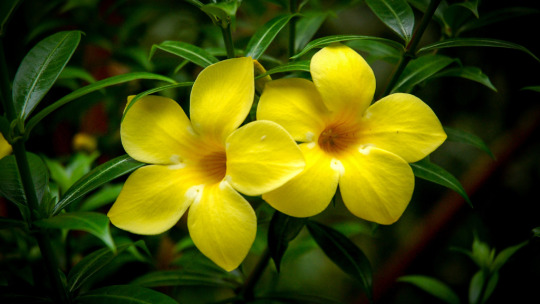
How to grow allamanda plant
Allamanda shrub and allamanda creeper both are propagated through stem cuttings. Initially choose a healthy matured mother plant and cut below the leaf node. While transplanting remove all the leaves from the bottom portion of the stem and leave two couple of leaves at the apical portion and place them in a pot. After 3-5 weeks roots start to generate.
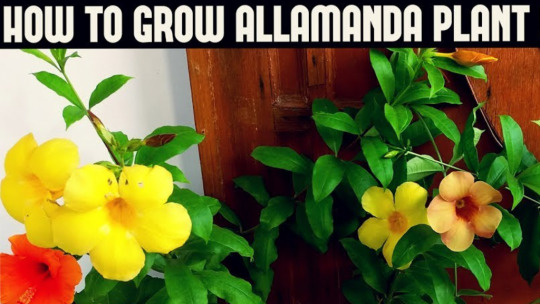
Soil
Allamanda survives in sandy loam soil. Excess water logging is not good for allamanda creepers. So, the PH range of soil should remain between 6.0 to 7.0. Induce the soil with organic matters like cow manure, and goat manure which provides additional nutrients to the plant. And mulching above the soil to maintain its moisture level.
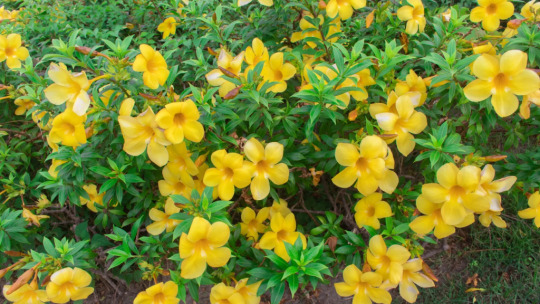
Flower
Allamanda creepers produce funnel-shaped flowers with five overlapped petals that spread outwards. There are a few varieties such as allamanda cream, allamanda chocolate, and allamanda Indonesia sunset. And popular varieties of allamanda flowers are allamanda cathartica and allamanda blanchetti.
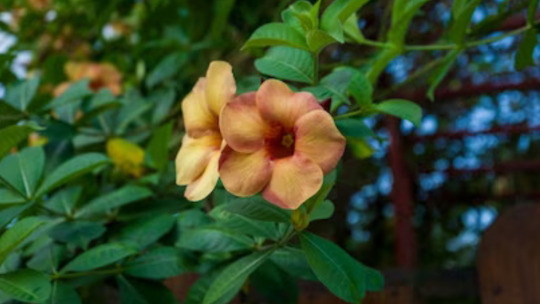
Fertilizers
Give NPK fertilizer at proper ratio in the gap of 2-4 weeks. fertilizer is given at the base of the plants.
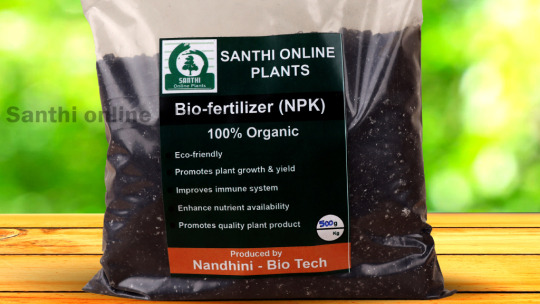
Pruning
Early spring is better for pruning just before new growth begins. To maintain overall health and appearance pruning is an essential thing that removes all diseased, dead, and damaged branches.
Usually, allamanda grows vigorously so, prune it according to your desired size.

Repotting
Repot the allamanda before its active growth begins. Choose a well-drained potting mix that is suitable for allamanda. After repotting water thoroughly until the water drains. The repotted allamanda placement done in indirect sunlight. Because direct sunlight can affect plant growth. So, inspect the plant's signs regularly.
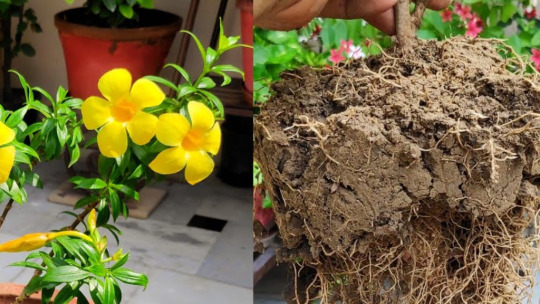
#Allamanda survives in sandy loam soil. Excess water logging is not good for allamanda creepers. So#the PH range of soil should remain between 6.0 to 7.0. Induce the soil with organic matters like cow manure#and goat manure which provides additional nutrients to the plant. And mulching above the soil to maintain its moisture level.#allamanda plant#Water#Allamanda creeper required a minimum amount of water to survive. At the same time#allamanda is intolerant to excessive water. Watering twice a week is enough for Allamanda.#allamanda creeper#Sunlight#Allamanda plants survive in full sunlight. Allamanda flower need minimum six hours of sunligt. Ample amount of sunlight is need for proper#allamanda cathartica#Flower#Allamanda creepers produce funnel-shaped flowers with five overlapped petals that spread outwards. There are a few varieties such as allama#allamanda chocolate#and allamanda Indonesia sunset. And popular varieties of allamanda flowers are allamanda cathartica and allamanda blanchetti.#alamanda flower#Fertilizers#Give NPK fertilizer at proper ratio in the gap of 2-4 weeks. fertilizer is given at the base of the plants.#alamanda creeper fertilizer#Pruning#Early spring is better for pruning just before new growth begins. To maintain overall health and appearance pruning is an essential thing t#dead#and damaged branches.#Usually#allamanda grows vigorously so#prune it according to your desired size.#allamanda blanchetti plant pruning#Repotting#Repot the allamanda before its active growth begins. Choose a well-drained potting mix that is suitable for allamanda. After repotting wate#inspect the plant's signs regularly.
0 notes
Text
Allamanda plant
The Allamanda plant is an evergreen perennial flowering plant that belongs to the family Apocynaceae. They are indigenous to America. Some varieties of allamanda yields colorful flowers. Many varieties of allamanda produce yellow flowers and few varieties of allamanda produce pink flowers. Allamanda plant usually grows up to 20 feet. Allamanda plants are classified based on their stem position such as creeper, climbers, and shrubs. It is used for traditional medicines to treat jaundice, malaria, and liver tumors.
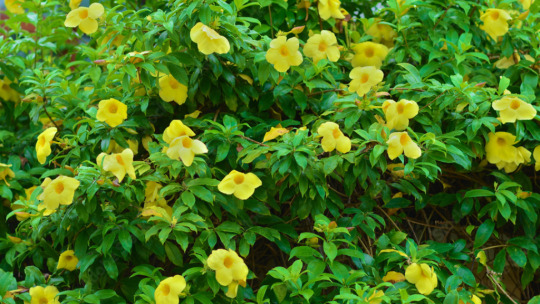
Allamanda varieties
Majorly two varieties of Allamanda are throughout the world.
Allamanda cathartica:
Allamanda cathartica is has another name called a golden trumpet. This variety produces dark yellow flowers. And this plant grows up to 15 feet tall.
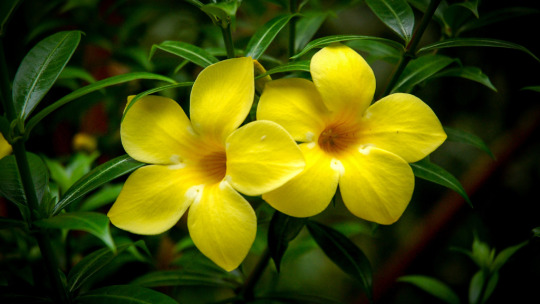
Allamanda blanchetti
Allamanda blanchetti is also known as purple allamanda. This variety produces a deep purple flower. And this plant grows up to 10 feet tall.
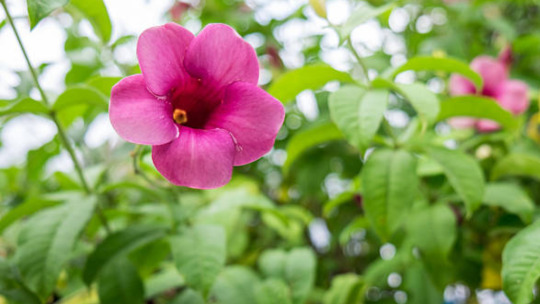
How to grow allamanda plant
Allamanda shrub and allamanda creeper both are propagated through stem cuttings. Initially choose a healthy matured mother plant and cut below the leaf node. While transplanting remove all the leaves from the bottom portion of the stem and leave two couple of leaves at the apical portion and place them in a pot. After 3-5 weeks roots start to generate
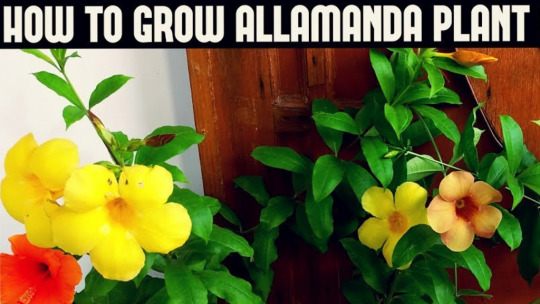
Soil
Allamanda survives in sandy loam soil. Excess water logging is not good for allamanda creepers. So, the PH range of soil should remain between 6.0 to 7.0. Induce the soil with organic matters like cow manure, and goat manure which provides additional nutrients to the plant. And mulching above the soil to maintain its moisture level.
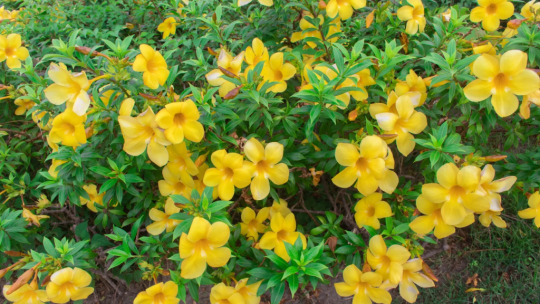
Water
Allamanda creeper required a minimum amount of water to survive. At the same time, allamanda is intolerant to excessive water. Watering twice a week is enough for Allamanda.

Benefits of allamanda
Allamanda blanchetti are praised for colorful shades and trumpet shape.
Allamanda flower attracts pollinators which promotes a healthy ecosystem.
In traditional medicine, many parts of allamanda are used for various purposes. Allamanda is highly used to treat skin infections, fever, and certain stomach issues.
Allamanda flower possesses some anti-inflammatory properties which reduce inflammation.
Plants play a vital role in purifying the air, providing oxygen and it creates a healthier ecosystem.
Allamanda-flower plant
Choose green go wild
Blog created by: www.santhionlineplants.com
#Soil#Allamanda survives in sandy loam soil. Excess water logging is not good for allamanda creepers. So#the PH range of soil should remain between 6.0 to 7.0. Induce the soil with organic matters like cow manure#and goat manure which provides additional nutrients to the plant. And mulching above the soil to maintain its moisture level.#allamanda plant#Water#Allamanda creeper required a minimum amount of water to survive. At the same time#allamanda is intolerant to excessive water. Watering twice a week is enough for Allamanda.#allamanda creeper#Sunlight#Allamanda plants survive in full sunlight. Allamanda flower need minimum six hours of sunligt. Ample amount of sunlight is need for proper#allamanda cathartica#Flower#Allamanda creepers produce funnel-shaped flowers with five overlapped petals that spread outwards. There are a few varieties such as allama#allamanda chocolate#and allamanda Indonesia sunset. And popular varieties of allamanda flowers are allamanda cathartica and allamanda blanchetti.#alamanda flower#Fertilizers#Give NPK fertilizer at proper ratio in the gap of 2-4 weeks. fertilizer is given at the base of the plants.#alamanda creeper fertilizer#Pruning#Early spring is better for pruning just before new growth begins. To maintain overall health and appearance pruning is an essential thing t#dead#and damaged branches.#Usually#allamanda grows vigorously so#prune it according to your desired size.#allamanda blanchetti plant pruning#Repotting#Repot the allamanda before its active growth begins. Choose a well-drained potting mix that is suitable for allamanda. After repotting wate
0 notes